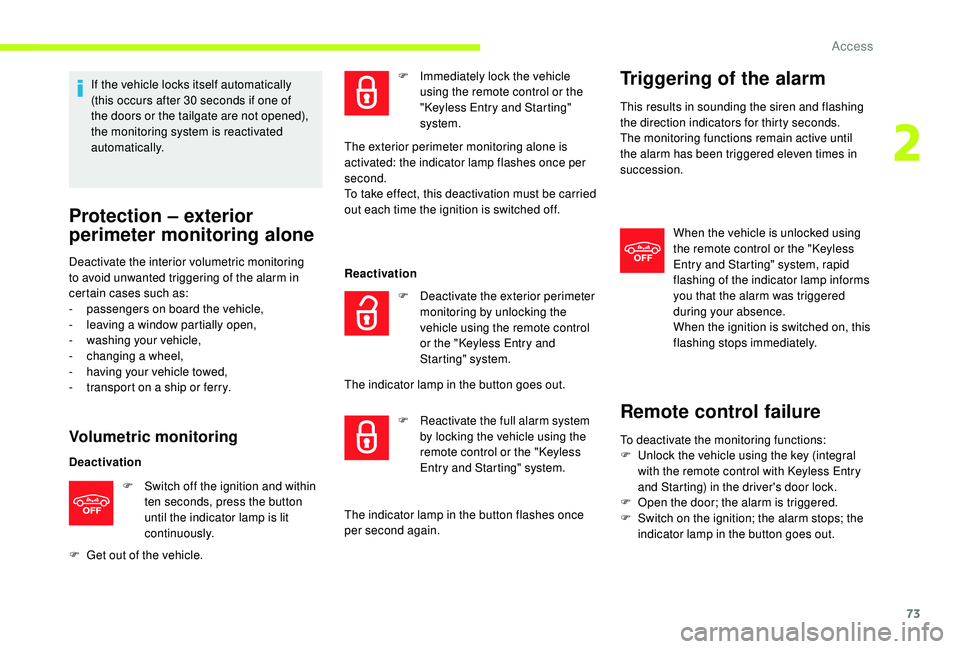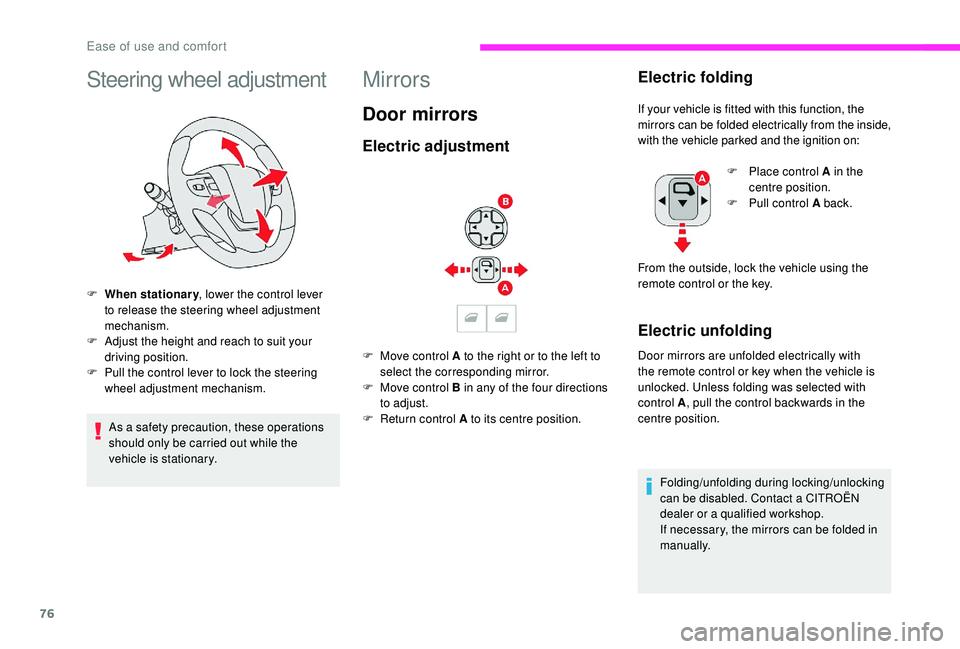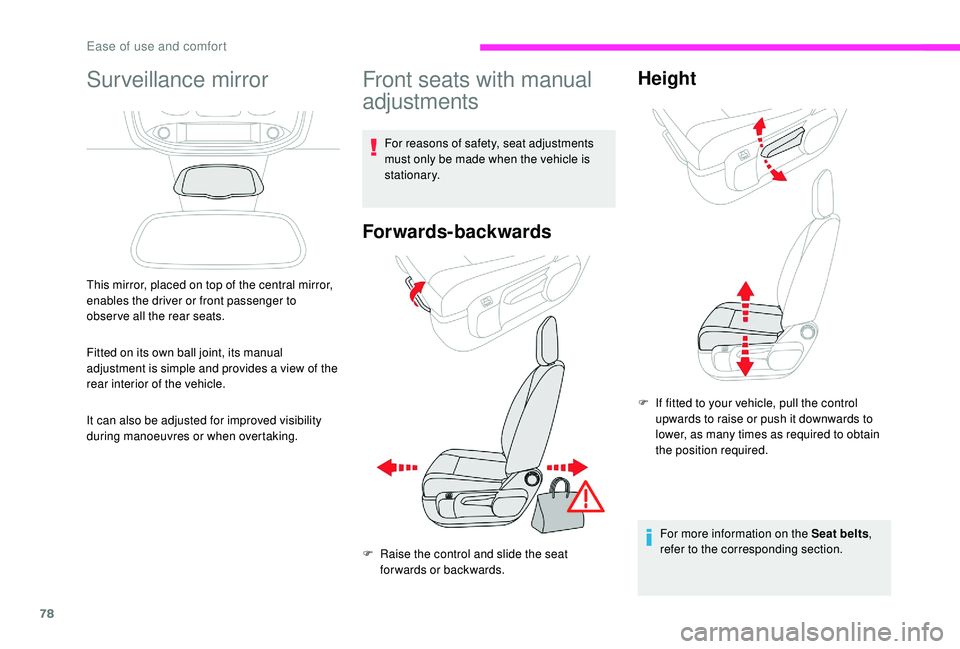CITROEN DISPATCH SPACETOURER DAG 2018 Handbook (in English)
Manufacturer: CITROEN, Model Year: 2018, Model line: DISPATCH SPACETOURER DAG, Model: CITROEN DISPATCH SPACETOURER DAG 2018Pages: 400, PDF Size: 16.99 MB
Page 71 of 400

69
If the left-hand door is not fully closed
(the right-hand door is not detected):
-
v
ehicle stationary and the engine
running, this warning lamp comes
on, accompanied by an alert
message for a few seconds,
-
v
ehicle moving (speed above
6
mph (10 km/h)), this warning
lamp comes on, accompanied
by an audible signal and an alert
message for a few seconds.
Opening to approximately 180°
If fitted to your vehicle, a check strap system
that allows the doors to be opened from about
90° to about 180°.
F
P
ull the yellow control when the door is
open.
The check strap will engage again
automatically on closing. When parking with rear
doors opened at 90°, they
conceal the rear lamps.
To signal your position to
other road users driving
in the same direction who
may not have noticed that
your vehicle has stopped,
use a warning triangle or
other device required by the
legislation in your country.
From inside
Opening
Vehicle locked and child lock off (disabled).
F
T
wist this handle down to fully unlock the
vehicle and open the right-hand door.
Vehicle unlocked and child lock disabled.
F
T
wist this handle down to open the right-
hand door.
If the child lock is on (enabled), the handle
is inoperative.
For more information on the Child lock ,
refer to the corresponding section.
Closing
F First close the right-hand door, then the left-hand door.
2
Access
Page 72 of 400

70
Tailgate
Opening
For more information on the Key, Remote
control or K eyless Entr y and Star ting ,
and in particular unlocking the vehicle,
refer to the corresponding section.
F
A
fter unlocking the vehicle with the key,
the remote control or the
K
eyless Entry
and Starting, pull the handle, then raise the
tailgate.
Closing
If the tailgate is not fully closed:
-
v
ehicle stationary and the engine running,
this warning lamp comes on, accompanied
by an alert message for a few seconds,
-
v
ehicle moving (speed above 6 mph
(10
km/h)), this warning lamp comes on,
accompanied by an audible signal and an
alert message for a few seconds.
For more information on the Key, Remote
control or
K
eyless Entr y and Star ting ,
and in particular locking the vehicle, refer
to the corresponding section.
Back-up control
It allows the mechanical unlocking of the
tailgate in the event of a battery or central
locking system malfunction.
Unlocking
F If fitted to your vehicle and if necessary, fold the rear seats to gain access to the lock
from inside.
Locking after closing
If the fault persists after closing again, the
tailgate will remain locked.
F
L
ower the tailgate using the interior grab
handle then push it home to fully close it.
F
I
nsert a small screwdriver into hole A of the
lock to unlock the tailgate.
F
M
ove the latch to the left.
Access
Page 73 of 400

71
Tailgate rear screen
The opening rear screen allows you to access
the rear of the vehicle directly, without having to
open the tailgate.
Opening
For more information on the Key, Remote
control or K eyless Entr y and Star ting ,
and in particular unlocking the vehicle,
refer to the corresponding section.
Closing
Close the rear screen by pressing the centre of
the glass until it is fully closed.
If the tailgate rear screen is not fully
closed:
After unlocking the vehicle using the key,
remote control or
K
eyless Entry and Starting
(depending on equipment), press this control
and raise the rear screen to open it. -
v
ehicle stationary and the engine running,
this warning lamp comes on, accompanied
by an alert message for a few seconds,
-
v
ehicle moving (speed above 6 mph
(10
km/h)), this warning lamp comes on,
accompanied by an audible signal and an
alert message for a few seconds. For more information on the Key, Remote
control or
K
eyless Entr y and Star ting
,
and in particular locking the vehicle, refer
to the corresponding section.
The tailgate and tailgate screen cannot
both be open at the same time, to avoid
damaging them.
2
Access
Page 74 of 400

72
Alarm
This system protects and provides a deterrent
against theft and break-ins.Self-protection function
The system checks for the disconnection
of any of its components.
The alarm is triggered if the battery,
button or siren wiring is disconnected or
damaged.
For all work on the alarm system,
contact a CITROËN dealer or a qualified
workshop.
Exterior perimeter
The system checks whether the vehicle is
opened.
The alarm is triggered if anyone tries to open
one of the doors, the tailgate or the bonnet.
Volumetric
The system checks for any variation in the
volume of the passenger compartment.
The alarm is triggered if anyone breaks a
window, enters the passenger compartment or
moves inside the vehicle.If your vehicle is fitted with Programmable
Heating/Ventilation, volumetric monitoring
is not compatible with this system.
For more information on Programmable
Heating/Ventilation , refer to the
corresponding section.
Total protection
Activation
F Switch off the ignition and get out of the vehicle.
F
L
ock the vehicle using the
remote control.
or
F
L
ock the vehicle using the "
K
eyless Entry
and Starting" system. The monitoring system is active: the indicator
lamp flashes once per second and the direction
indicators come on for about 2
seconds.
Following a command to lock the vehicle
using the remote control or the "
K
eyless Entry
and Starting" system, the exterior perimeter
monitoring is activated after 5 seconds, the
interior volumetric monitoring after 45 seconds.
If an opening element (door, tailgate or side-
hinged doors, bonnet, etc.) is not closed fully
after locking with the "remote control", the
vehicle is not locked but monitoring will be
activated after 45
seconds.
Deactivation
F Press this unlocking button on
the remote control.
or
F
U
nlock the vehicle using the "
K
eyless Entry
and Starting" system.
The monitoring system is deactivated: the
indicator lamp for the button goes out and the
direction indicators flash for about 2
seconds.
Access
Page 75 of 400

73
If the vehicle locks itself automatically
(this occurs after 30 seconds if one of
the doors or the tailgate are not opened),
the monitoring system is reactivated
automatically.
Protection – exterior
perimeter monitoring alone
Deactivate the interior volumetric monitoring
to avoid unwanted triggering of the alarm in
certain cases such as:
-
p
assengers on board the vehicle,
-
l
eaving a window partially open,
-
w
ashing your vehicle,
-
c
hanging a wheel,
-
h
aving your vehicle towed,
-
t
ransport on a ship or ferry.
Volumetric monitoring
Deactivation F
S
witch off the ignition and within
ten seconds, press the button
until the indicator lamp is lit
continuously.
F
G
et out of the vehicle. F
I
mmediately lock the vehicle
using the remote control or the
"
K
eyless Entry and Starting"
system.
The exterior perimeter monitoring alone is
activated: the indicator lamp flashes once per
second.
To take effect, this deactivation must be carried
out each time the ignition is switched off.
Reactivation F
D
eactivate the exterior perimeter
monitoring by unlocking the
vehicle using the remote control
or the "
K
eyless Entry and
Starting" system.
The indicator lamp in the button goes out.
F
R
eactivate the full alarm system
by locking the vehicle using the
remote control or the " K eyless
Entry and Starting" system.
The indicator lamp in the button flashes once
per second again.
Triggering of the alarm
This results in sounding the siren and flashing
the direction indicators for thirty seconds.
The monitoring functions remain active until
the alarm has been triggered eleven times in
succession.
When the vehicle is unlocked using
the remote control or the "
K
eyless
Entry and Starting" system, rapid
flashing of the indicator lamp informs
you that the alarm was triggered
during your absence.
When the ignition is switched on, this
flashing stops immediately.
Remote control failure
To deactivate the monitoring functions:
F U nlock the vehicle using the key (integral
with the remote control with
K
eyless Entry
and Starting) in the driver's door lock.
F
O
pen the door; the alarm is triggered.
F
S
witch on the ignition; the alarm stops; the
indicator lamp in the button goes out.
2
Access
Page 76 of 400

74
Locking the vehicle without
activating the alarm
F Lock or deadlock the vehicle using the key (integral with the remote control with
K
eyless Entry and Starting) in the driver's
door lock.
Malfunction
When the ignition is switched on,
fixed illumination of the button’s
indicator lamp indicates a fault in the
system.
Have it checked by a CITROËN
dealer or a qualified workshop.
Automatic activation
This function is either not available, an option
or is standard.
2
minutes after the last opening element (door
or tailgate) is closed, the system is activated
automatically.
F
T
o avoid triggering the alarm on entering
the vehicle, first press the unlocking button
on the remote control or unlock the vehicle
using the "
K
eyless Entry and Starting"
system.
Electric windows
Manual mode
Press or pull the control gently, without
exceeding the resistance point. The window
stops as soon as the control is released.
Automatic mode
Press or pull the control fully, beyond the
resistance point. The window opens or closes
completely when the switch is released.
Pressing the switch again stops the movement
of the window.
Safety anti-pinch
If your vehicle is fitted with the safety anti-pinch
function, when the window rises and meets an
obstacle, it stops and partially lowers.
In the event of unwanted opening of the window
on closing, press the control until the window
opens completely. Within 4
seconds, pull the
control until the window closes.
The safety anti-pinch does not operate while
doing this.
Reinitialisation
Following reconnection of the battery, the anti-
pinch safety function must be reinitialised.
F
L
ower the window fully, then raise it, it will
rise in steps of a few centimetres each time
the control is pressed.
F
R
epeat the operation until the window is
fully closed.
F
C
ontinue to pull the switch upwards for
at least one second after reaching this
position, window closed.
1
L
eft electric window control.
2
R
ight electric window control. The electrical functions of the electric windows
are deactivated:
-
a
pproximately 45 seconds after the ignition
is switched off,
-
a
fter one of the front doors is opened, if the
ignition is off.
Access
Page 77 of 400

75
The safety anti-pinch does not operate
while doing this.
Always remove the key when leaving the
vehicle, even for a short time.
In the event of contact during operation
of the windows, you must reverse the
movement of the window. To do this, press
the switch concerned.
When operating the passenger electric
window switches, the driver must ensure
that no-one is preventing correct closing
of the windows.
The driver must ensure that the
passengers use the electric windows
c o r r e c t l y.
Be aware of children when operating the
windows.
2
Access
Page 78 of 400

76
Steering wheel adjustment
F When stationary, lower the control lever
to release the steering wheel adjustment
mechanism.
F
A
djust the height and reach to suit your
driving position.
F
P
ull the control lever to lock the steering
wheel adjustment mechanism.
As a safety precaution, these operations
should only be carried out while the
vehicle is stationary.
Mirrors
Door mirrors
Electric adjustment
F Move control A to the right or to the left to select the corresponding mirror.
F
M
ove control B in any of the four directions
to adjust.
F
R
eturn control A to its centre position.
Electric folding
If your vehicle is fitted with this function, the
mirrors can be folded electrically from the inside,
with the vehicle parked and the ignition on:
Electric unfolding
Door mirrors are unfolded electrically with
the remote control or key when the vehicle is
unlocked. Unless folding was selected with
control A , pull the control backwards in the
centre position.
Folding/unfolding during locking/unlocking
can be disabled. Contact a CITROËN
dealer or a qualified workshop.
If necessary, the mirrors can be folded in
manually. F
P
lace control A in the
centre position.
F
P
ull control A back.
From the outside, lock the vehicle using the
remote control or the key.
Ease of use and comfort
Page 79 of 400

77
Heated mirrors
If your vehicle has heated door mirrors:
orF
P
ress the heated mirror button.
For more information on Rear screen
demist - defrost , refer to the associated
section. As a safety measure, the mirrors should
be adjusted to reduce the blind spots.
The objects obser ved are, in reality, closer
than they appear.
Take this into account in order to
correctly judge the distance of vehicles
approaching from behind.Rear view mirror
Equipped with an anti-dazzle system, which
darkens the mirror glass and reduces the
nuisance to the driver caused by the sun,
headlamps from other vehicles, etc.
Manual model
Adjustment
F
A djust the mirror so that the glass is
directed correctly in the "day" position. Day/night position
F
P
ull the lever to change to the "night" anti-
dazzle position.
F
P
ush the lever to change to the normal
"day" position.
Automatic "electrochrome"
model
F Press the heated rear window button.
In order to ensure optimum visibility during
your manoeuvres, the mirror lightens
automatically when reverse gear is
engaged.
This system automatically and progressively
changes between day and night use by means
of a sensor measuring the light coming from the
rear of the vehicle.
3
Ease of use and comfort
Page 80 of 400

78
Surveillance mirror
This mirror, placed on top of the central mirror,
enables the driver or front passenger to
observe all the rear seats.
Fitted on its own ball joint, its manual
adjustment is simple and provides a view of the
rear interior of the vehicle.
It can also be adjusted for improved visibility
during manoeuvres or when overtaking.
Front seats with manual
adjustments
For reasons of safety, seat adjustments
must only be made when the vehicle is
stationary.
Forwards-backwards
F Raise the control and slide the seat forwards or backwards.
Height
F If fitted to your vehicle, pull the control upwards to raise or push it downwards to
lower, as many times as required to obtain
the position required.
For more information on the Seat belts ,
refer to the corresponding section.
Ease of use and comfort